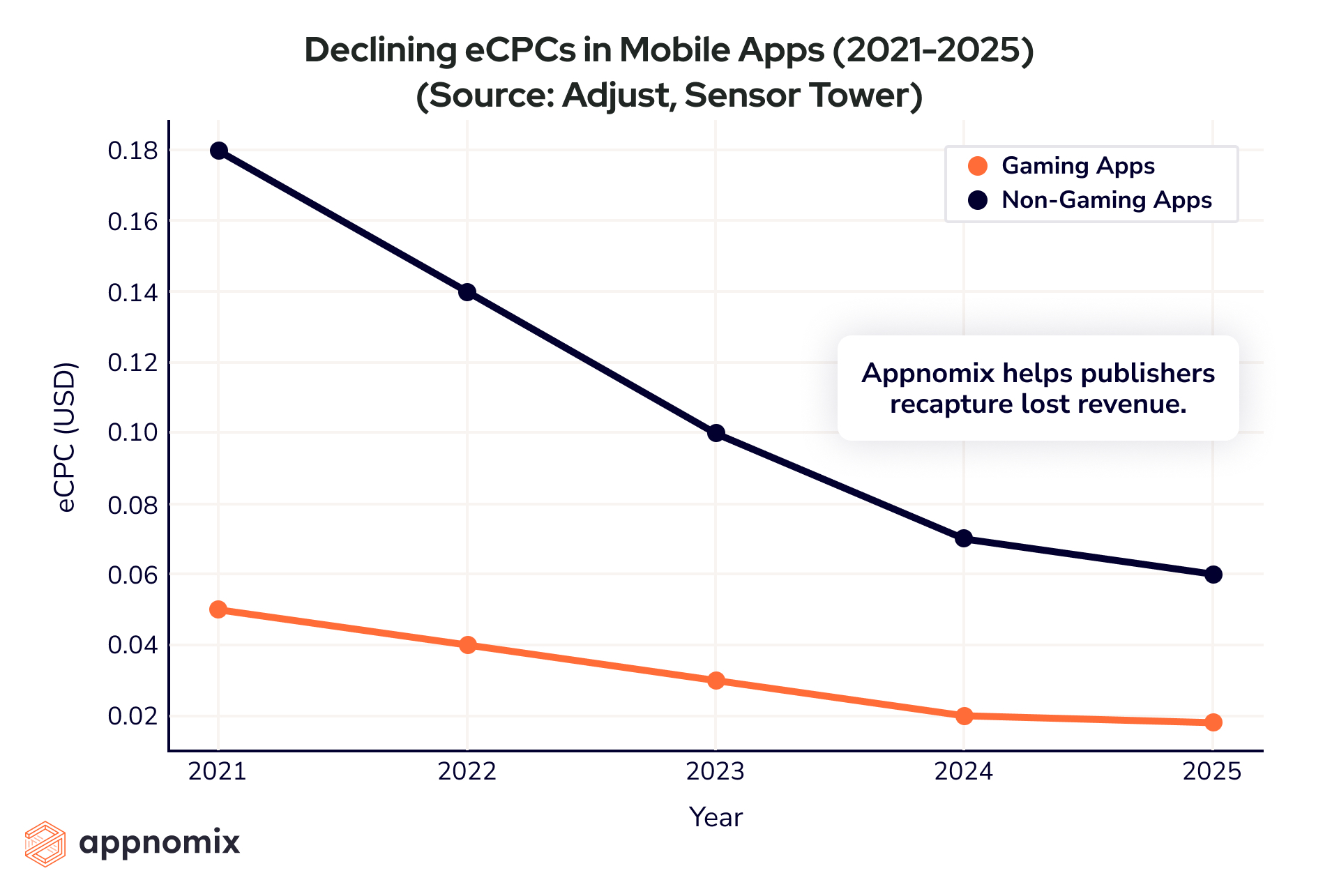Monetizing the $1.3 Trillion Shift: How App Publishers Can Capture the Commerce Opportunity
The convergence of technology and retail is bringing forward new opportunities for app publishers to diversify their revenue streams with mobile commerce. Appnomix’s new AI-powered commerce infrastructure allows app publishers to improve both user experience and loyalty while also tapping into the lucrative world of e-commerce.
Understanding the Current Limitations of In-App Monetization
Many app publishers face challenges with traditional in-app monetization strategies. Advertising yields are under pressure: the average cost-per-click rose 16% in 2024, and customer acquisition costs have climbed nearly 60% over five years. At the same time, users are increasingly desensitized to ads and privacy restrictions have further weakened ad targeting. This makes ad revenue a shrinking piece of the monetization mix, and relying on ads alone can hinder growth.
The decline is clear in the latest benchmarks: Adjust reports that the global median eCPC fell from $0.04 in 2023 to $0.03 in the first half of 2024, a 25% drop. This mirrors the steady downward trend shown in the chart, underscoring how ad revenue has become a shrinking piece of the monetization mix.

Moreover, the current market dynamics suggest that app publishers are missing out on a substantial share of revenue. It is projected that North American e-commerce sales will reach about $1.3 trillion in 2025, with consumers averaging more than $2,000 annually in online spending. Collectively, this is spending that flows through mobile devices but largely outside of non-retail apps. Publishers have no participation in this revenue stream when their users leave their apps to shop. By adopting a more user-centric approach, they can redefine the in-app experience, foster loyalty and capture a portion of that spend.
The Scale of the Opportunity: Unlocking New Revenue Streams
Imagine the revenue potential for app publishers with turnkey access to a robust commerce infrastructure. With the integration of Appnomix’ AI-powered Commerce SDK, publishers can offer personalized shopping experiences that cater to individual user preferences. This not only enhances engagement but also encourages repeat visits and prolonged app usage. Additionally, by providing users with tailored recommendations and exclusive deals, publishers can create an environment that feels both rewarding and engaging.
Appnomix’ access to an extensive network of 50,000 merchants and over one billion products ensures publishers will always connect users with products aligned to their interests and needs. The ability to suggest relevant items enhances the overall user experience, positioning the app as a trusted resource rather than just a tool for a specific purpose.
Appnomix works by helping users discover the best prices and discounts as they shop the mobile web. Participation is activated inside of the app user flow, but the real value is created outside of the app experience itself. The result is increased revenue, brand loyalty and retention without disrupting user experience.
Integrating commerce into apps also presents an opportunity to deepen connections with users. By offering value beyond the app environment (e.g. loyalty programs, discounts and smart shopping assistance), publishers can foster a community of loyal customers. This shift not only increases satisfaction but also opens up a significant new revenue channel that has traditionally been inaccessible to app providers.
Real-World Examples in Commerce Integration
Consider a successful app like Spotify. With more than 50 million subscribers, retaining their user base is critical. With Appnomix’s commerce infrastructure and SDK, Spotify could extend its value by offering a branded shopping assistant to support its users across the mobile web.
For example, a Spotify subscriber shopping for television at Walmart.com might see a Spotify-branded assistant surface at checkout, offering smarter options:
“There is a better price for this television at Best Buy.”
“The item in your cart has a 25% off coupon today at Walmart.”
By making these types of intelligent, real-time recommendations, Spotify could deliver value for its users outside the app, foster brand loyalty, and capture commerce revenue that would otherwise go untapped. This is not just hypothetical. Appnomix is already active on millions of devices and is generating an average of between $3-12 in revenue-per-user annually. Developers are discovering this new way to generate revenue from out-of-app purchases without replacing ads or disrupting in-app user experience and monetization. It’s proof that commerce integration can be complementary, not cannibalistic to revenue growth.
The novelty and competitive advantage of integrating commerce into apps cannot be understated. As Ian Newfeld of Appnomix observed, “Giving users the ability to shop smarter across the mobile web and then capitalizing on those revenue opportunities is not something apps have traditionally done.”
By offering unique features that provide real value, app publishers can differentiate themselves, attract new users and retain existing ones, ultimately leading to increased revenue potential.
Getting Started: Implementing Commerce Infrastructure
For app publishers ready to enter the world of commerce, the first step is to assess current offerings and identify gaps in value. Understanding user needs and preferences is critical. Publishers can conduct surveys, analyze user behavior and explore market trends to inform their strategy. Once a clear understanding of the target audience is established, it’s time to consider how to implement commerce features effectively.
Utilizing an AI-powered SDK, such as Appnomix, can streamline the integration process. The SDK enables publishers to offer personalized shopping experiences without overwhelming users with irrelevant options. With data-driven insights and AI, publishers can deliver curated product selections that resonate with their audience, enhancing satisfaction and driving conversions. Unlike ad networks experimenting with early-stage commerce ad formats, Appnomix’s infrastructure is designed for partnerships and branded value, not ad placements. That distinction matters: it allows publishers to extend their brand into the shopping journey instead of simply running ads for someone else.
With access to millions of data points related to product SKUs, pricing and availability, the SDK ensures consumers always have access to the best deals and discounts on a wide range of products and promotions. By aligning with reputable merchants, publishers can guarantee that users receive quality offerings, further elevating the app’s credibility. This partnership approach not only enriches the user experience but also establishes a source of income through affiliate commissions.
The Net Gain
Integrating commerce into apps is no longer a distant possibility; it’s a present opportunity for publishers willing to innovate. By providing additional value to users, publishers can create a compelling user experience that fosters loyalty and drives revenue. Embracing AI-powered commerce infrastructure will empower app publishers to stand out in a crowded marketplace, ensuring they are equipped for the future of mobile commerce.
If you’re ready to transform your app and explore the potential of commerce integration, consider connecting with Appnomix. Whether you’d like a demo or to discuss partnership opportunities, the path to enhancing user experience and unlocking new revenue channels starts right here. Let’s embark on this exciting journey together.
Author
-

Ian Newfeld is CEO of Appnomix, where he drives sales strategy, product positioning, and strategic partnerships to accelerate market penetration and revenue growth. He blends deep product expertise with data-driven operations to scale organizations while cultivating long-term customer relationships.
